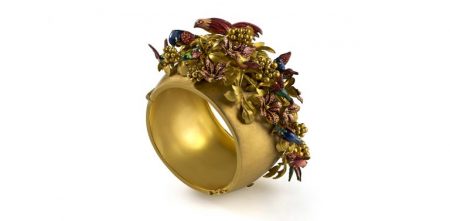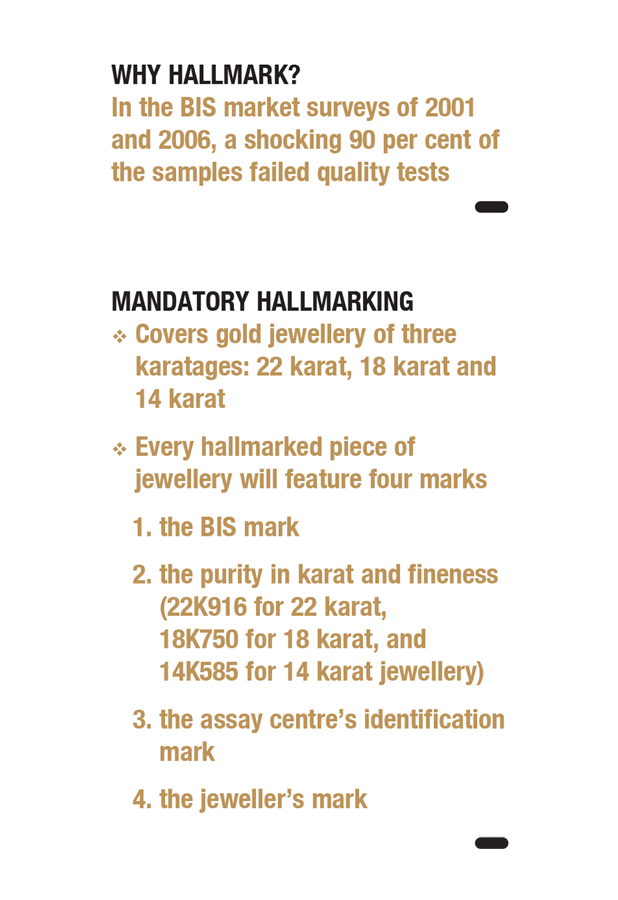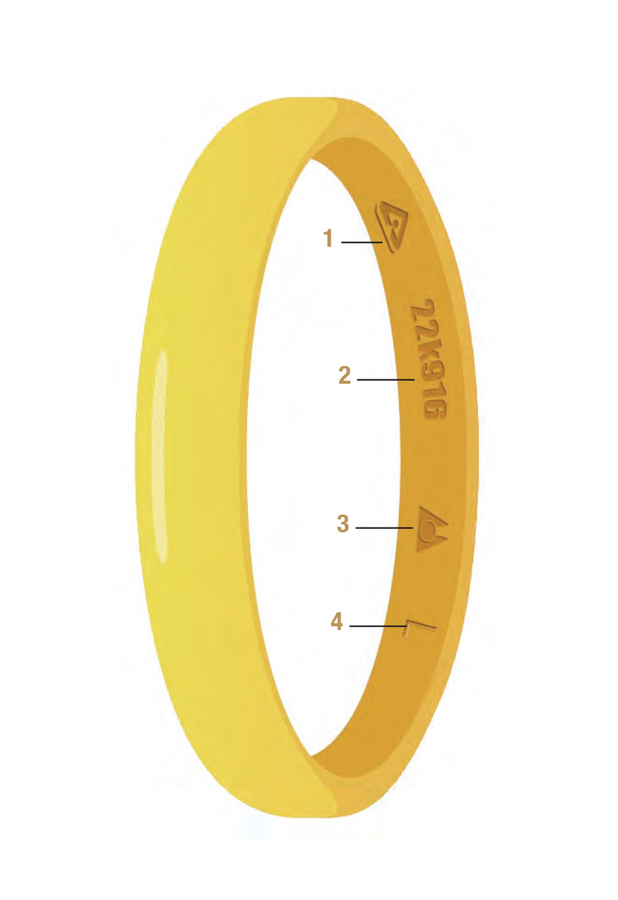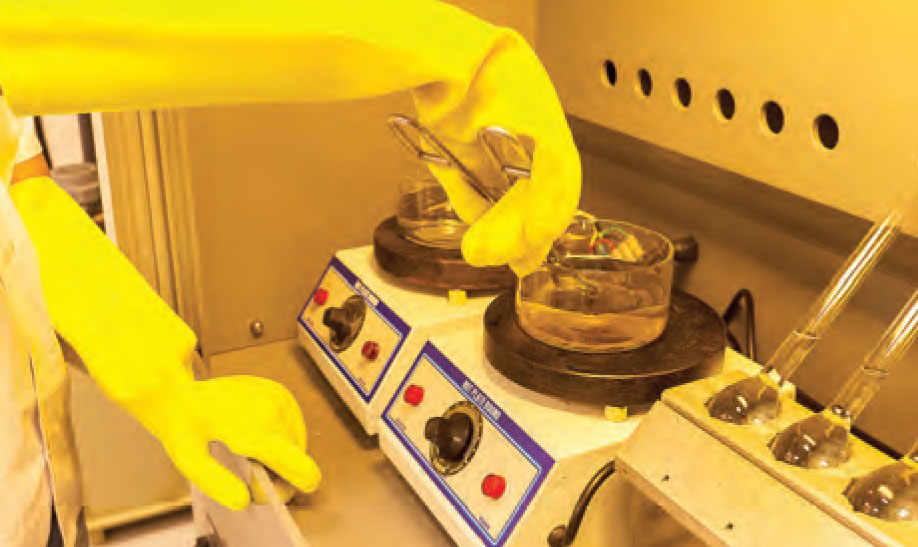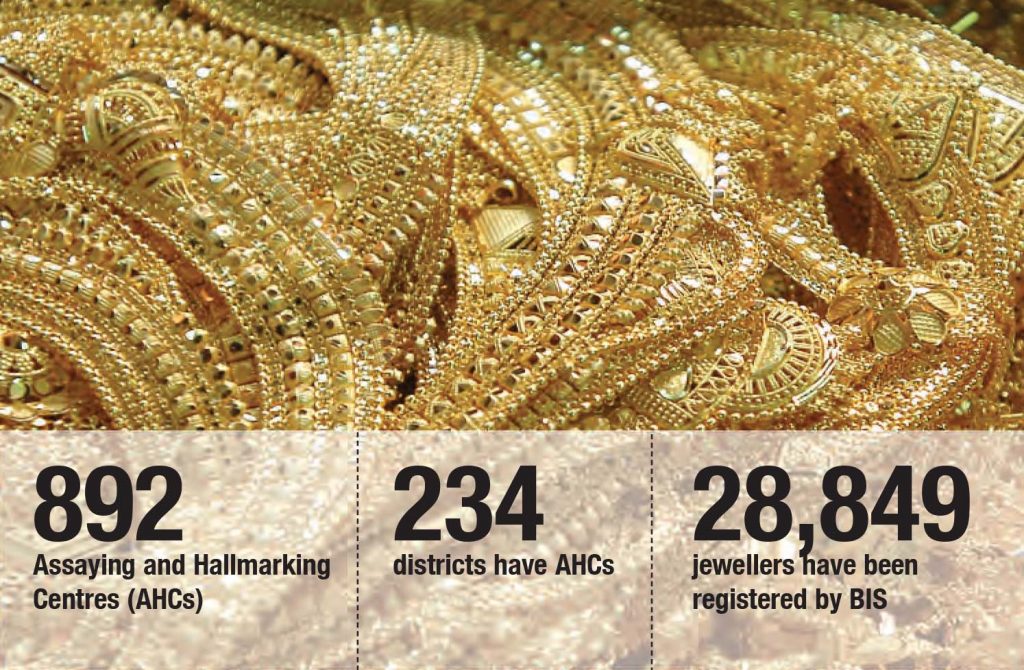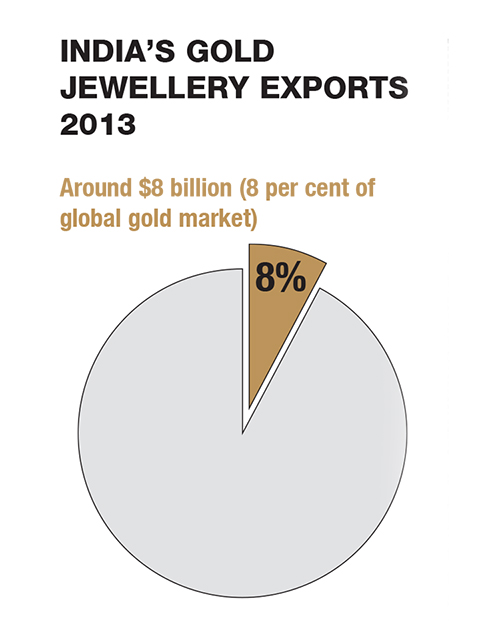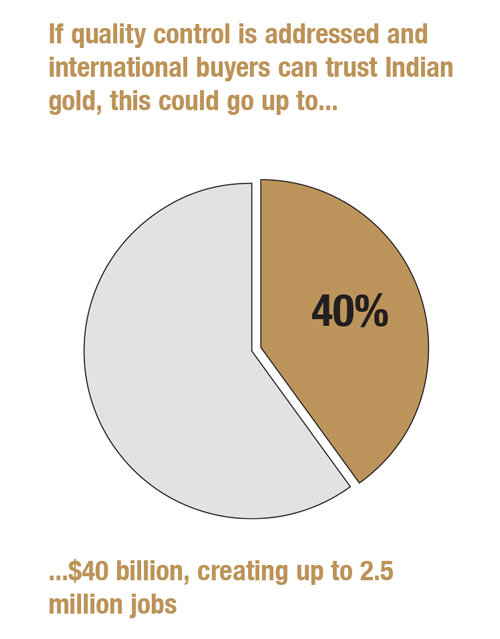After much discussion and hand-wringing for over two decades, the mandatory hallmarking of gold will finally become a reality in India. The industry has been unequivocal in its support for the regulation, but experts believe much remains to be done about improving and upgrading jewellery manufacturing standards and the quality standards of the assaying and hallmarking centres
In India, gold the most noble of all metals is set to become nobler still. Gold hallmarking will be made mandatory, almost twenty-five years since the first discussions on the subject. The Department of Consumer Affairs is giving jewellers until January 2021, a year from the government notification, to register with the Bureau of Indian Standards (BIS), clear their existing stocks, and ensure the sale of only hallmarked gold.
The industry has been unequivocal in its support for the regulation, which it agrees will bring several benefits to consumers and to the trade, including to the export segment. Industry observers believe that much remains to be done about improving and upgrading jewellery manufacturing standards as well as the quality standards of the assaying and hallmarking centres. However, there can be no doubt that mandating hallmarking is an important milestone on the road to reforming the Indian gold sector.
An equitable exchange of money for goods or services is one of the basic tenets of business – one that has been flouted by jewellers time and again. This alleged widespread under-karatage of gold by jewellers across the country has been welldocumented by the BIS market surveys of 2001 and 2006, in which a shocking 90 per cent of the samples had failed quality testing. Ram Vilas Paswan, the Union Minister for Consumer Affairs, Food and Public Distribution, stated at a press conference in New Delhi on 14 January 2020 that the purpose of making hallmarking mandatory for gold jewellery and artefacts is ‘to ensure that consumers are not cheated while buying gold ornaments and that get the purity as marked.’
Concurring with the minister’s point of view, K Srinivasan, Convener – Gold Jewellery Panel, GJEPC (Gem & Jewellery Export Promotion Council), notes, ‘The government’s decision to make gold hallmarking mandatory is the right move. Customers must get the purity of gold for which they are paying, that is, they must get value for their money. This measure will make the industry more disciplined and highly competitive.’ Dr C Vinod Hayagriv, Managing Director and Director of heritage jewellery house C Krishniah Chetty Group of Jewellers, and past chairman of the All India Gem & Jewellery Domestic Council (GJC), offers his perspective: ‘I was part of the delegation that went to The Kathmandu Convention in 1995 to rally for bringing hallmarking to India. BIS is the appropriate body to monitor standards. I have no regret about the current hallmarking standards or the laws/policy implemented. I do believe it’s among the best in the world.’
Surendra Mehta, National Secretary, India Bullion & Jewellers Association Ltd (IBJA), adds that he would have preferred hallmarking to have been implemented in phases over the next few years. Mehta states, ‘Mandatory hallmarking at one go in the entire country may not be a good idea, but must be implemented in a phased manner, first in the metropolitan cities and thereafter in ‘B’ and ‘C’ cities, gradually over a period of five-seven years. The industry must adhere to consumer requirement of hallmarking jewellery instead of disputing the mechanism to implement hallmarking. This is a must to regain the confidence and trust of the customer.’ Citing the technical nature of the hallmarking process, Surendra Mehta wants jewellers to be exempt from prosecution for any wrongdoing related to hallmarking for a period of two years. ‘Every change in the policy will have its own challenges and each problem coming out of such challenges can be resolved by the industry itself. Hence, it is necessary that for the first 24 months of its implementation, penalties and prosecution are not launched against jewellers. It is important for the government to understand that hallmarking is a technical subject and goods are hallmarked based on a sampling mechanism. Hence, penalizing someone from day one may not be a good idea. Let the mechanism evolve by itself.’
The majority of experts whom Solitaire spoke to agreed that a year’s time was more than sufficient for jewellers to clear their existing inventory. On that point, Rajesh Khosla, Chairman Emeritus of LBMA-accredited gold refinery MMTC-PAMP India Pvt. Ltd, states, ‘Gold jewellery lends itself to recycling ad infinitum, with the underlying asset not losing its characteristic. One year seems quite reasonable.’
LETTER OF THE LAW
The BIS Act, 2016, states
Chapter III Section 18.1 (Obligations of license holder, seller, etc.) The license holder shall, at all times, remain responsible for conformance of the goods, articles, processes, systems or services carrying the Standard Mark.
Relevant sections from the Draft Regulations quoted below:
Section 1.7.1: The certified jeweller shall remain responsible for purity and fineness of the hallmarked article sold by him.
Section 1.7.2: The certified jeweller may sell hallmarked precious metal articles, which are marked with the identification mark of any other certified jeweller, provided evidence of purchase or authorization in any other form is available with him.
Section 1.7.4: The certified jeweller, who makes the sale to the consumer, shall pay compensation to consumer for any shortage in purity or fineness as specified by the Bureau irrespective of whether the article bears his identification mark or he is selling articles under provisions of sub-regulation (2).
Section 1.7.5: The certified jeweller may also sell such hallmarked precious metal articles, which are marked with the identification mark of any other certified jeweller, provided evidence of purchase or authorization in any other form is available with him. In such cases, the jeweller getting the article hallmarked and whose identification mark is on the article shall be responsible for purity and fineness.
Section 1.7.10: The certified jeweller, who makes the sale to consumer, shall pay compensation to consumer for any shortage in purity or fineness as specified by Bureau irrespective of whether the article bears his identification mark or his selling articles under provisions of regulation 7(5) above.
WGC INDIA MD SOMASUNDARAM PR’S VIEWS ON HALLMARKING
‘The gold industry in India is at the cusp of transformation, as transparency, standards and infrastructure begin to define the next phase of reforms. Making hallmarking mandatory is a much-awaited progressive step that safeguards the interests of the consumers, particularly women, who put their hard-earned savings into this asset class. This reform should be backed by a tight enforcement mechanism and has the potential to enhance trust in Indian gold jewellery, thereby enabling a favourable environment to market our famed handcrafting skills appropriately. Employment potential in assaying and hallmarking will increase. Hallmarking will also create a level playing field, benefitting small players. The transition time of one year will allow the industry enough time to sell the existing inventory, while simultaneously plugging any gaps in infrastructure and making suitable changes in logistics. To make this a smooth process, government and the industry players should also create a strong consumer pull through consumer awareness campaigns.
However, GJC Chairman Anantha Padmanabhan asserts in an email interview that jewellers should be given more than 18 months to shift to the approved karatages, besides other suggestions for the government. ‘Yes, we would like to add a few more categories like 20 karat, 23 karat and 24 karat. And the time period that the government has given us is 12 months, but we expect beyond 18 months for the jewellers to shift to the announced karatages,’ Padmanabhan asserts.
Taking issue with the demand for additional purity grades, IBJA’s Surendra Mehta states, ‘While there is demand for hallmarking of 20- karat jewellery, I personally feel this demand is illogical, it has been made with no basis or thought. The records of the gem and jewellery sector will not show even 1 per cent sale of 20-karat jewellery. Making such a demand raises suspicion in the eyes of the government that the entire industry might have been manufacturing 20-karat jewellery but selling it as 22-karat.’
In the same vein, James Jose adds, ‘The restriction on multiple karatages, limiting them to the sufficiently wide selection of 14 karats, 18 karats and 22 karats, was initiated by the Honourable Minister for Consumer Affairs, Ram Vilas Paswan, for better consumer protection.’
As of now, the hallmarking scheme does not extend to bullion. ‘But in due course, a regulatory authority for good delivery bullion, acceptable to banks and commodity exchanges, shall be coming up and mandatory hallmarking of bullion bars also may be introduced, providing full traceability, using blockchain technology and ensuring responsible sourcing practices,’ reveals Jose, who started the first BIS-recognized gold hallmarking centre in the country on 11 April 2000 in Cochin.
‘Hallmarking centres are not meant to be treated as the quality control department of the jewellery retailer. Instead, they are doing only random verification of the jewellery submitted to them, to certifying it as per BIS standards. Hallmarking is 10 per cent testing, and 90 per cent trusting the jeweller’s quality control systems and procedures,’
– James Jose, Managing Director of CGR Metalloys Private Limited, Cochin, and the past secretary of The Indian Association of Hallmarking Centres.
THINKING GLOBAL
The move to make gold hallmarking mandatory is likely to enhance the Indian jewellery industry’s reputation worldwide and have a positive impact on sales to tourists as well as on jewellery exports. Responsible Jewellery Council (RJC) Executive Director Iris Van der Veken says, ‘We welcome the gold hallmarking initiative from the Indian government. It is a positive step and should provide consumers with additional confidence about the purity of the gold they are buying. This is especially important in a market where gold is bought predominantly by weight.’ When asked whether India should pursue membership of the International Hallmarking Convention, she notes, ‘This is definitely something worth looking into as otherwise, the Indian hallmarking scheme may not be recognised internationally.’
Jose informs, ‘India is pursuing membership of the International Hallmarking Convention, with its own processes and procedures taking several years’ time for completion. Several of the hallmarking centres in India have expressed their willingness to join the Vienna Convention. As and when the country becomes a member of the Vienna Convention, these hallmarking centres will be audited by the international team, subsequent to which, these centres shall be permitted to hallmark the fifth mark, that is, the mark of the Vienna Convention on hallmarking.’
EXPORT BONANZA
Although the mandatory hallmarking scheme relates primarily to the domestic sector, the unintended but grateful beneficiary of a standardized, national hallmarking scheme may just be the export segment. The World Gold Council (WGC), in its 2015 report ‘Developing Indian hallmarking – A roadmap for future growth’, notes, ‘Artisanal Indian jewellery is widely prized for its intricacy and craftsmanship. Yet, India currently (as of 2013) exports around $8 billion of gold jewellery, equivalent to just 8 per cent of the global gold market. This has significant potential to increase if quality control is addressed. ‘Our firm belief is that enhancing the hallmarking system in India will rebuild trust in the purity of Indian gold, increase consumer confidence, enhance exports and create employment. It would also be an essential element in any successful gold monetization programme and a critical element to India becoming “jeweller to the world”,’ the WGC states in the same report.
Quoting from the same World Gold Council report, GJEPC Vice Chairman Colin Shah states that mandatory hallmarking could increase India’s jewellery exports to $40 billion and create 2.5 million jobs ‘if global markets had more faith in the integrity of Indian jewellery, and if local consumers, overseas buyers and financial markets could place their trust in the quality and purity of Indian gold.’ All jewellery exports from India are mandatorily checked at the port of entry of their destination countries because the country has, so far, lacked a national hallmarking system. Instituting such a system will allow India to become a signatory to the Vienna Convention, which grants an automatic waiver of all such inspections to member countries.
– WGC’s 2015 report ‘Developing Indian hallmarking – A roadmap for future growth’
CATCH 22-K
The spectre of mandatory hallmarking hovered for several years over the domestic jewellery industry, which resisted it with the argument that there wasn’t adequate infrastructure to implement the order, given the country’s large retailer base and logistics issues in smaller towns and villages, where the majority of gold is consumed. The BIS too was cautious about opening more hallmarking centres due to poor demand at existing ones leading to a type of chicken-andegg situation.
Hallmarking by itself is not the solution. Jewellery manufacturing technology also needs an upgrade. And assay and hallmarking need serious international collaboration and intervention, which also includes review of the BIS norms, which are two decades old. There is simply too much of a trust deficit between jewellers and hallmarkers, and Band-aid therapy will lead us nowhere
– RAJESH KHOSLA, Chairman-Emeritus, MMTC-PAMP India Pvt. Ltd
However, as of 31 December 2019, there are 892 Assaying and Hallmarking Centres (AHCs) spread across 234 districts and so far, 28,849 jewellers have been registered by the BIS. Refuting the ‘inadequate infrastructure’ argument, James Jose explains, ‘Each hallmarking centre has the capacity to mark 1,000 pieces in a shift, which is around 10 kg per shift or 3,000 kg (3 tonnes) per year. At this rate, the 892 hallmarking centres in the country can easily hallmark 2,500 tonnes of jewellery per annum, as against the average sales of 1,000 tonnes per annum in the country. Hence, we do not visualize any capacity constraints or infrastructural bottlenecks in the mandatory hallmarking regime.’ In an interview with Solitaire in 2006, a top BIS official had spoken of two possible approaches to making hallmarking mandatory: the first was the top-down approach of simply declaring it so, and the second, bottom-up approach would entail generating enough publicity about hallmarking so that jewellers would have to give in to consumer pressure and provide hallmarked jewellery.
Industry bodies like the IBJA and GJC have committed themselves to raising consumer awareness about hallmarking. ‘Yes, we will promote awareness of hallmarking in all our B2C activities,’ asserts Padmanabhan. Dr Hayagriv adds, ‘There is adequate consumer awareness about hallmarking in the cities. However, trade bodies need to do more to educate customers in smaller towns and cities. BIS alone cannot do this. We must lend a hand in the interest of fair trade practice.’ Surendra Mehta remarks, ‘IBJA, through its social media and other websites, recommends people buy only hallmarked jewellery. At IBJA, we regular conduct multiple hallmarking seminars across India. Apart from this, BIS also conducts various workshops to raise awareness among jewellers. As far as consumer awareness is concerned, BIS has launched a campaign promoting the purchase of hallmarked jewellery. We have also carried out a survey and have found 40 per cent of consumers asking for hallmarked jewellery. This number is rising by the day.’
THREAT OF TECHNOLOGICAL OBSOLESCENCE
Rajesh Khosla believes that there is a danger of India’s hallmarking technology becoming obsolete and requiring further investment. ‘That is the clear and present danger, as the technology, introduced as far back as the late 1990s, is sorely in need of an upgrade to international standards. Hallmarking of jewellery enjoins upon the jeweller tendering jewellery for hallmarking to declare the gold purity in the jewellery being tendered, and upon the hallmarking centre to do a scientific assay to verify that the gold content is not less than that declared. Both participants are liable for any misdeclaration or misdemeanour.
We would like to add a few more categories like 20 karat, 23 karat and 24 karat. And the time period that the government has given ueee1b8s is 12 months, but we expect beyond 18 months for the jewellers to shift to the announced karatages.
– ANANTHA PADMANABHAN, Chairman, All India Gem & Jewellery Domestic Council (GJC)
Industry associations need to take the lead in addressing this trust deficit by creating a network of AHCs of the highest integrity. This needs investment, and the government does provide financial support. But in the current race of descending to the lowest common denominator, quality and consistency are the first casualties. The only answer is a radical technology leap, akin to the leap we saw in the automobile and telecom industries. Regrettably, there are no shortcuts,’ Khosla warns.
DIGITAL UPGRADE
In response, Jose says that although hallmarking technology periodically becomes obsolete, it is simultaneously upgraded by the BIS, with the addition of new operating standards and technological improvements such as the digital hallmarking scheme. ‘Digital hallmark will take Indian hallmarking to greater heights, with improved transparency of operations, for which the hallmarking centres may have to upgrade their machinery in terms of precision and faster turnaround time. In addition to the existing chemical method of fire assay, new operating standards for analytical methods such as Silicone drift detector-based XRF, spark optical emission spectrometry, etc., are in various stages of development by the BIS, making the Indian hallmarking industry truly world class.
‘It is understood that the mandatory regime announced by the minister, with a grace period up to 15 January 2021, shall coincide with the launch of the BIS digital hallmarking scheme, ensuring 100 per cent consumer protection,’ Jose reveals.
Khosla offers a final word of advice: ‘Hallmarking by itself is not the solution. Jewellery manufacturing technology also needs an upgrade. The use of quality alloying elements, quality solders, etc., must become a sine qua non for the gold jewellery manufacture. And assay and hallmarking needs serious international collaboration and intervention, which also includes review of the BIS norms, which are two decades old. There is simply too much of a trust deficit between jewellers and hallmarkers, and Band-aid therapy will lead us nowhere.’

